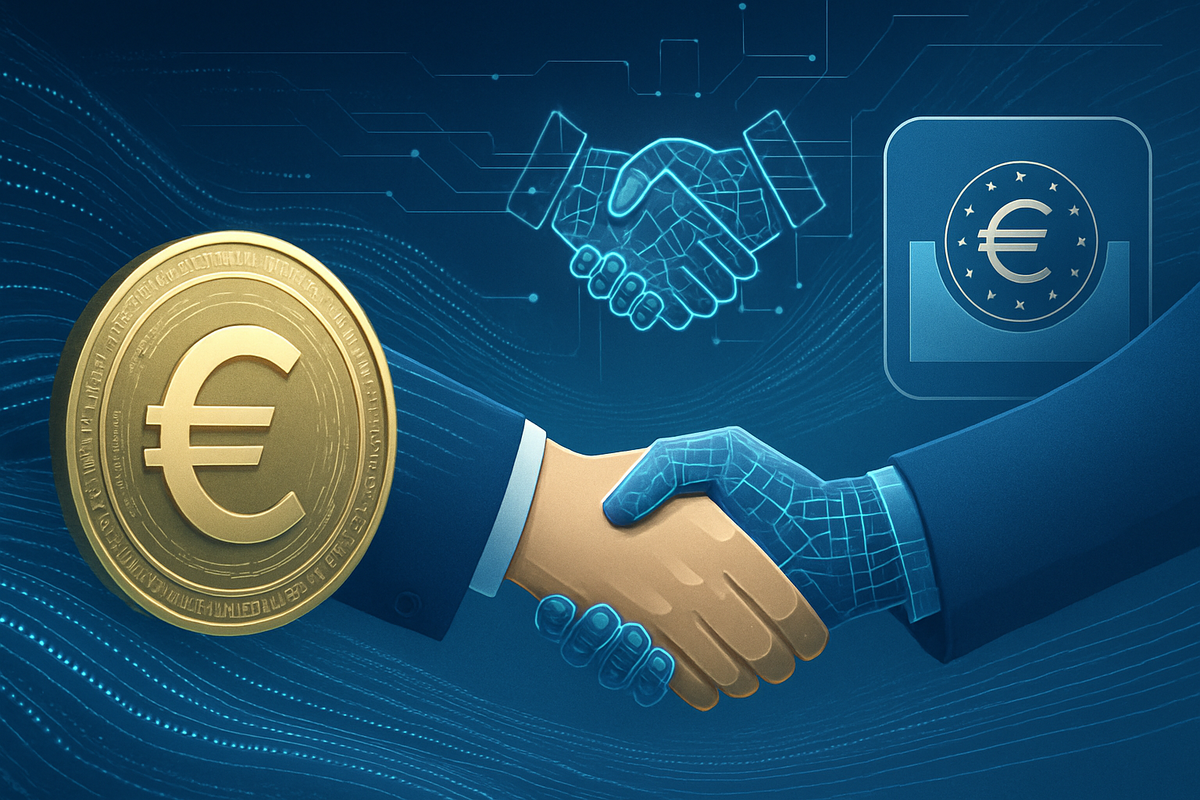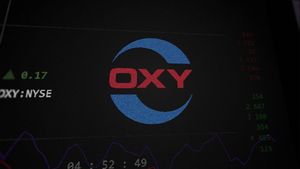
The European Central Bank (ECB) has reached a pivotal milestone in its ambitious digital euro project, announcing on October 2, 2025, the conclusion of framework agreements with a cohort of technology partners. This strategic move signals significant progress in the "preparation phase" of the digital currency, bringing Europe closer to a potential launch of its own central bank digital currency (CBDC) by the end of the decade. The partnerships are crucial for developing the foundational infrastructure, addressing core functionalities like offline payments and robust fraud prevention, and laying the groundwork for a secure and resilient digital euro ecosystem.
This development positions the Eurosystem as a frontrunner in the global race to develop CBDCs, aiming to offer a sovereign digital payment option that complements physical cash. The selection of these specialized firms underscores the ECB's commitment to building a digital euro that prioritizes privacy, resilience, and security, key attributes for public acceptance and widespread adoption.
Forging the Digital Foundation: Key Partners and Project Timeline
The ECB's recent announcement solidifies its commitment to advancing the digital euro, a project designed to offer a sovereign digital payment option for European citizens and businesses. On October 2, 2025, the central bank unveiled the results of its rigorous selection process, entering into framework agreements with seven entities tasked with developing critical components of the digital currency. This development follows the initiation of the project's preparation phase on November 1, 2023, a two-year period dedicated to refining the digital euro's design and technical specifications.
Among the key selections, a consortium spearheaded by Giesecke+Devrient (G+D), in collaboration with Nexi (BIT:NEXI) and Capgemini (EPA:CAP), emerged as the first-ranked tenderer for an end-to-end offline payment solution. This crucial capability aims to replicate the privacy and resilience of physical cash, allowing transactions to occur without internet connectivity or power, and critically, without recording payment details by banks, payment service providers, or even the central bank itself. This emphasizes the ECB's dedication to user privacy and system robustness.
Concurrently, Feedzai, in partnership with PwC, secured the top spot for developing the central fraud detection and prevention mechanism. This system is designed to assess and mitigate fraud risks across all digital euro transactions, assigning a fraud risk score to each. The framework agreement for this component alone is estimated to be valued between €79.1 million and €237.3 million, underscoring the ECB's priority on security. Additional partners like Sapient GmbH and Tremend Software Consulting were selected for pseudonym lookups, Almaviva SpA and Fabric SpA for app and SDK development, and Senacor FCS for securing payment information exchange.
While these agreements establish the terms for future work, they do not entail immediate payments. The actual development and integration of these components will hinge on a subsequent decision by the ECB Governing Council, following the adoption of the Digital Euro Regulation and the conclusion of the current preparation phase, which is expected by the end of 2025. An ECB official has indicated a potential launch timeline for the digital euro as early as 2029, suggesting a phased approach that still requires significant legislative and developmental steps.
The Digital Euro's Winners and Losers in the Tech Race
The ECB's selection process has created clear frontrunners in the race to build the digital euro's foundational infrastructure, positioning several key technology firms for significant roles and long-term benefits. These framework agreements, while not guaranteeing immediate payment, establish the selected partners as primary candidates for the actual development work, should the project proceed to implementation.
Feedzai, a global leader in AI-powered financial crime prevention, stands out as a major winner. Securing the contract for the central fraud detection and prevention solution places the company at the heart of the digital euro's security architecture. This not only promises a substantial, long-term revenue stream, with the framework agreement valued potentially up to €273 million, but also dramatically elevates Feedzai's global credibility and brand recognition. This high-profile engagement with the ECB provides a powerful reference, potentially opening doors to similar CBDC projects with other central banks worldwide and solidifying its competitive edge in the RiskOps market.
PwC, partnering with Feedzai, also emerges as a significant beneficiary. Its involvement in delivering the fraud detection mechanism reinforces its strong expertise in financial crime technology, regulatory compliance, and the implementation of complex digital infrastructures. This role not only contributes to its revenue but also provides a valuable case study, positioning PwC favorably for future advisory, integration, and implementation roles as the digital euro project progresses and as other central banks explore their own CBDCs.
The consortium led by Giesecke+Devrient (G+D), alongside Nexi (BIT:NEXI) and Capgemini (EPA:CAP), is another clear winner, tasked with developing the crucial end-to-end offline payment solution. G+D, with its deep experience in secure currency technology, will lead the development of a unique feature that aims to mimic cash-like privacy and resilience. This bolsters G+D's reputation as a global leader in security technology and positions it to influence global standards for offline CBDC capabilities. Nexi (BIT:NEXI), leveraging its expertise in point-of-sale (POS) and payment technology, benefits from a strategic role in a core component, reinforcing its status as a leading European PayTech company. Its prior involvement in prototyping exercises further solidifies its advantageous position. Capgemini (EPA:CAP) contributes its technology consulting and digital transformation expertise, strengthening its standing as a premier partner for digital transformation in the financial sector and opening avenues for ongoing involvement in the digital euro and similar governmental initiatives.
Conversely, the "losers" in this scenario are primarily those technology partners or consortia that bid for these specific tenders but were not selected, or those who chose not to participate. While this does not imply a negative impact on their existing business operations, it represents a missed opportunity to secure a foundational role in one of Europe's most significant monetary innovations. The selected partners now have a distinct advantage in shaping the future of digital payments within the Eurozone and potentially influencing the global CBDC landscape.
A New Era for European Payments: Wider Significance and Global Context
The ECB's strategic alliances for the digital euro resonate far beyond the immediate technical development, positioning Europe at the forefront of a global monetary transformation. This move is emblematic of a broader, accelerating trend among central banks worldwide to explore and implement Central Bank Digital Currencies (CBDCs), driven by the imperative to maintain the relevance of public money in an increasingly digital economy. With over 130 countries actively investigating CBDCs, the digital euro project contributes significantly to shaping international standards and approaches.
One of the most profound implications lies in strengthening Europe's strategic autonomy in payments. Currently, the European payments landscape is heavily reliant on non-EU private payment providers. The digital euro aims to provide a sovereign, pan-European digital payment solution, fostering greater competition within the market and reducing dependence on external entities. This push for independence aligns with the broader geopolitical goal of enhancing Europe's economic sovereignty and resilience. Furthermore, by designing the digital euro as a public good, available free of charge for basic use, the ECB seeks to ensure financial inclusion and provide a widely accepted, safe, and trusted means of payment, particularly through its innovative offline capabilities.
The ripple effects on existing financial institutions and payment providers will be substantial. Commercial banks and Payment Service Providers (PSPs) will be tasked with integrating the digital euro into their existing infrastructure and customer-facing services. While the digital euro is a direct liability of the central bank, its successful adoption hinges on seamless private sector intermediation. Concerns persist among traditional banks regarding potential deposit outflows to the digital euro, which could impact liquidity and funding costs. To mitigate these risks, the ECB is actively considering holding limits for individual digital euro accounts, potentially around €3,000. This delicate balancing act aims to introduce a new form of money without destabilizing the existing financial system.
In the nascent but rapidly evolving digital asset space, the introduction of a sovereign-backed digital euro could significantly impact private stablecoins, particularly those pegged to the euro. A stable, secure, and officially sanctioned digital euro could attract users seeking reliability, potentially offering a robust alternative to privately issued digital currencies. However, some market participants foresee a "multi-coin" environment where regulated stablecoins could complement CBDCs by serving niche use cases not covered by the central bank's offering. The ECB's exploration of decentralized technologies, as evidenced by pilot programs involving the XRP Ledger and WhiteNetwork, also signals an openness to integrating innovative blockchain-based solutions for specific functionalities like real-time cross-border payments.
Historically, the ECB's approach aligns with a global trend of public-private partnerships in CBDC development. Countries like Sweden, with its e-krona pilot involving Accenture, have demonstrated the efficacy of central banks collaborating with private firms to leverage specialized technical expertise. China's digital yuan (e-CNY) offers a precedent for large-scale CBDC rollout, albeit with a different governance model. The ECB's meticulous, multi-partner approach, emphasizing privacy, resilience, and security, reflects a careful calibration aimed at building a digital currency that upholds European values while embracing technological advancement. The legal tender status proposed by the European Commission underscores the digital euro's foundational role as a public good, designed to complement cash and support the international standing of the euro in a digital world.
The Road Ahead: What Comes Next for the Digital Euro
Following the pivotal selection of technology partners, the European Central Bank's digital euro project now enters a critical phase of intense development and strategic navigation, with a target launch set for mid-2029. The immediate focus for the selected partners, including Giesecke+Devrient (G+D), Nexi (BIT:NEXI), Capgemini (EPA:CAP), Feedzai, and PwC, will be to finalize detailed planning and timelines for the design, integration, and development of the Digital Euro Service Platform (DESP). This involves translating the framework agreements into concrete technical specifications and commencing the arduous process of building the digital currency's core infrastructure.
In the short term, as the "preparation phase" concludes by October 2025, the ECB's Governing Council will make a crucial decision on the project's progression. This decision is contingent on the advancement of the necessary European Union legislative process, with a general agreement among member states expected by the end of 2025 and the European Parliament anticipated to formalize its position by May 2026. Should these legislative hurdles be cleared, the coming years will see intensified development, rigorous testing of components like offline payment capabilities, and the finalization of the digital euro scheme rulebook, ensuring consistent functionality across the Eurozone. Ongoing engagement with the public, policymakers, retailers, and payment service providers will also be vital to refine the digital euro's design to meet diverse user needs.
Looking further ahead towards the 2029 launch, the long-term possibilities for the digital euro are transformative. It aims to provide a unified, universally accessible payment method across the euro area, bolstering European strategic autonomy and fostering innovation. The digital euro could serve as a platform for advanced features such as programmable payments, enabling automated transactions based on predefined conditions. However, the path is not without its challenges and potential strategic pivots. Legislative delays could push back the launch timeline, and the ECB must carefully balance privacy concerns with anti-money laundering (AML) requirements. Mitigating potential bank disintermediation through measures like holding limits (e.g., €3,000 per user) will be crucial for maintaining financial stability. Ensuring widespread merchant and consumer adoption will also necessitate demonstrating clear added value over existing payment methods and seamless integration with current payment systems.
Several scenarios could unfold. A successful and phased launch by mid-2029, predicated on timely legislative alignment and robust technical implementation, would see the digital euro achieve significant adoption, strengthening European payment sovereignty. Conversely, delays due to legislative impasses or unforeseen technical complexities could diminish its strategic impact, allowing private stablecoins or foreign CBDCs to gain further traction. There is also the possibility of limited adoption if the digital euro fails to offer compelling advantages, relegating it to a niche payment option. However, even in such a scenario, the project's development and accompanying regulatory discussions are likely to catalyze broader innovation within the European digital payments ecosystem, pushing banks and fintechs to enhance their own offerings. The ECB's digital euro project is now a tangible reality in its development, but its ultimate success hinges on agile adaptation, political will, and widespread public acceptance.
A Digital Horizon: Wrap-up and Investor Outlook
The European Central Bank's selection of technology partners for the digital euro marks a seminal moment, solidifying the project's trajectory towards a potential launch in 2029. This strategic move underscores the ECB's commitment to delivering a robust, private, and resilient central bank digital currency, designed to complement cash and enhance Europe's financial sovereignty in an increasingly digital world. The partnerships with firms like Giesecke+Devrient (G+D), Nexi (BIT:NEXI), Capgemini (EPA:CAP), Feedzai, and PwC are foundational, laying the technical groundwork for crucial functionalities such as offline payments and advanced fraud prevention.
Moving forward, the market will witness a dynamic interplay of technological development, legislative progress, and stakeholder engagement. The digital euro is poised to foster innovation within the European payments industry, potentially streamlining transactions and accelerating cross-border payments. While challenges such as concerns from commercial banks regarding deposit outflows persist, the ECB's deliberate approach, emphasizing privacy, inclusivity, and carefully considered holding limits, aims to mitigate these risks and ensure financial stability. This initiative represents one of Europe's most significant monetary innovations since the introduction of the euro itself, designed to safeguard the role of public money and promote financial inclusion in a digital age.
Investors should closely monitor several key developments in the coming months. Foremost is the legislative progress within the EU, with critical agreements expected by the end of 2025 and formal parliamentary approval potentially by May 2026. The outcomes of the current preparation phase, concluding in October 2025, and the subsequent decision by the ECB's Governing Council will be pivotal. Keep an eye on the second round of technical experimentation planned for 2026, which will offer further insights into potential use cases and feasibility. Additionally, track the progress of the selected technology partners as they move from framework agreements to actual development. The evolving landscape of existing payment providers and the parallel development of euro-denominated stablecoins by major European banks under the MiCA framework will also shape the broader digital payments ecosystem. The digital euro project is a multi-year endeavor, and vigilance in these areas will be crucial for identifying long-term opportunities and risks within Europe's evolving digital finance sector.
This content is intended for informational purposes only and is not financial advice






